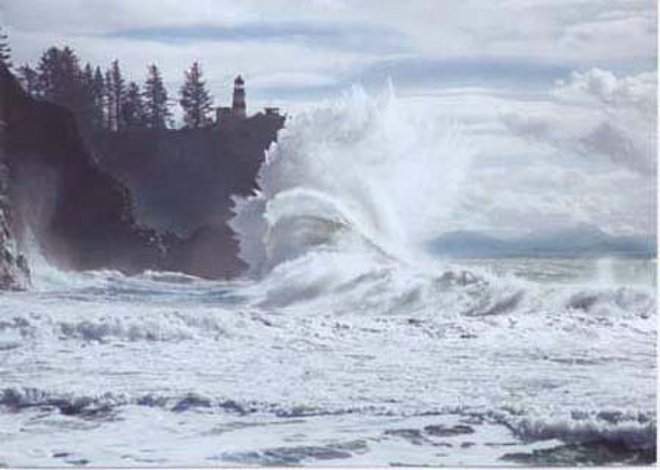Meteotsunamis in the
Laurentian Great Lakes
Characterization,
Forecast, and Warning
Meteotsunamis
can pose a serious threat to the Great
Lakes coast, owing to the lake’s
characteristics that facilitate the formation of
destructive meteotsunamis including frequent
fast-moving storm fronts, resonance-promoting
bathymetry, and harbors to finally amplify the wave.
The most vivid historical meteotsunami on record in
the Lake Michigan occurred in 1954,
when
a squall line-induced wave struck Chicago in Lake
Michigan. The coast was inundated up to 50 meters
inland and unexpectedly swept many fishermen off of
the Montrose Harbor piers, killing seven. While the
threat of meteotsunamis in Lake Michigan has been
recognized, to date no infrastructure for detecting
and warning of a pending meteotsunami disaster is
available. Recently the potential hot spots in Lake
Michigan that can be threatened by meteotsunamis has
been identified and characterized.
Meteotsunamis have also observed in Lake
Superior and Lake
Erie. In collaboration researchers in Great Lakes
Environmental Research Laboratory and Prairie
Research Institute at the University of Illinois
at Urbana-Champaign, we are
implementing an observation network system to better
understand the occurrence of meterotsunamis. An
operational meteotsunami forecasting and warning
system is also being developed to keep
residents safe and avoid dangerous events. Further
efforts on meteotsunami research, education,
outreach can be found in the following links:
Media
- Scientists:
15-minute storm caused Lake Michigan rip
currents that killed 7 hours later, Sheboygan
Press, April 29, 2019.
- Lake
Michigan’s deadly ‘freak wave’ of 1954 is
Chicago folklore. Turns out it was a
meteotsunami. And they happen pretty often.,
Chicago Tribune, April 25, 2019.
- Damaging
Water Events – Meteotsunami Vs. Seiche,
9and10new, April 25, 2019
- Meteotsunami
forecasting efforts underway in light of
recent research, The Badger Herald, April 2,
2019
- UW-Madison
Professor: Great Lakes Tsunamis Found To Spur
Rip Currents, Northland Outdoors, March 25,
2019
- Researchers
pinpoint cause of deadly Lake Michigan rip
current, March 19, 2019
- UW-Madison
professor: Great Lakes tsunamis found to spur
rip currents, Superior Telegram. March 18,
2019
- Scientists
discover that meteotsunamis can cause rip
currents, Univ. of Wisconsin-Sea Grant, March
14, 2019
- Great
Lakes tsunamis found to spur rip currents,
Duluth News Tribune, March 14, 2019
- Great
Lakes tsunamis found to spur rip currents,
Lake County News Chronicle, March 14, 2019
- Thunderstorms…With
a Chance of Tsunami? Wisconsin Engineer,
December 2018.
- Meteotsunamis:
a lesser known Great Lakes hazard, Daily
Mining Gazette, Nov. 2018.
- Meteotsunamis:
Monitoring the menace in the Great Lakes,
August 25, 2018.
- Major
Waves on the Great Lakes – Meteotsunamis,
INFOSUPERIOR, August 2018.
- Great
Lakes Meteotsunami Experts Hone in on Big Wave
Forecasts, Environmental Monitoring, July
2018.
- Meteotsunamis
by Tom
Skilling, Feb 2018, WGN9-TV, Chicago.
- Prevalence
and danger of little known tsunami type
revealed, not quakes, Cosmos Magazine, Feb.
19, 2018
- The
Weather Channel News; There’s a Type of
Tsunami on the Great Lakes You May Not Have
Heard of Before, Feb. 13, 2018
- Great
Lakes Threat: Meteotsunamis, Weather-Science,
Feb 13, 2018
- Tsunamis?
on The Great Lakes? They happen — Sometimes
with deadly results, Detroit Free Press, Jan.
23, 2018
- Meteotsunamis
in the Great Lakes, The Manitoulin Expositor,
July 2017
- 專
家研氣象海嘯預報-減大浪造成傷亡數目, June 24, 2017,

- Tsunamis
on the Great Lakes? Researchers are looking
into it, Toronto TheStar, June
2017.
- Tsunamis on the Great
Lakes? Researchers are looking into it,
CBC Morning Show,
June 26, 2017
- Le
météo-tsunami, un danger qui guette Grands
Lacs, Nouvelles,
June 2017
- Great
Lakes Tsunamis Coming? Great Lakes Echo,
June 25, 2017
- Researchers
find meteotsunamis are an underrated hazard in
the Great Lakes, Wisconsin State Farmer,
November 2016
- Thunderstorms
Produce Tsunami-like Waves in the Great Lakes,
ISWS, May 2016.
- Wisconsin
Sea Grant Study Reveals Cause of Monster Waves
on Lake Michigan, UW-Sea Grant, April 2016
- Tsunamis
on Superior? Minnesota Public Radio, April
2016
- Researchers
find tsunamis on the Great Lakes, Mlive, April
2016.
- Researchers
discover 'tsunamis' on Great Lakes, Duluth
News Tribune April 2016
- Tsunamis
from the sky: Can meteotsunamis be forecast?
Earth Magazine, 2012
- Freak
'Meteotsunamis' Can Strike On a Sunny Day,
Live Science, December 2012.
- Meteotsunamis, Coastal
Engineering Project, 2010
Publications:
- Lin, L.C., Liu, W.C., Wu, C.H., 2024, Meteotsunamis in
the Tamsui River estuary, Taiwan. Estuarine, Coastal
and Shelf Science, 108704, https://doi.org/10.1016/j.ecss.2024.108704.
- Lin, L.C., Liu, W.C., Wu, C.H., 2024, A
16-year meteotsunami climatology in the coastal
areas of southern Asia-Pacific Ocean, Frontiers
of Marine Science,
https://doi.org/10.3389/fmars.2023.1333843
- Lin, L.C. and Wu, C.H., 2021, Unexpected
meteotsunamis prior to Typhoon Wipha and Typhoon
Neoguri,Natural Hazards, 106:1673–1686, https://doi.org/10.1007/s11069-020-04313-0
- Linares, A., Wu, C.H., Bechle, A.J., Anderson,
J.A., and Kristovich, D.A, Unexpected rip
currents induced by a meteotsunami, Scientific
Reports, doi:10.1038/s41598-019-38716-2,
2019.
- Linares, A., Wu, C.H., Anderson, J.A., Chu,
P.Y., Role of meteorologically-induced
water level oscillations on bottom shear stress
in freshwater estuaries in the Great Lakes. J.
Geophysical Research-Oceans, In Press, doi:10.1029/2017JC013741,
2018.
- Bechle, A.J., Wu, C.H., David A.R. Kristovich,
D.A., Anderson, E.J., Schwab, D.J., Rabinovich,
A.B., 2016. Meteotsunamis in the Laurentian
Great Lakes, Scientific
Reports,
6, 37832, doi:10.1038/srep37832.
- Linares, A., Bechle, A.J., and Wu,C.H., 2016,
Characterization and Assessment of the
meteotsunami hazard in northern Lake Michigan, Journal
of Geophysical Research-Oceans, 121(9),
7141–7158.
- Bechle, A.J., Kristovich, D.A, and Wu, C.H.,
2015. Meteotsunami Occurrences and Causes in
Lake Michigan, Journal
of Geophysical Research-Oceans, 120
(12),8422–8438.
- Anderson, E.J., Bechle, A.J., Wu, C.H.,
Schwab, D.J., Mann, G. and Lombardy, K. 2015.
Reconstruction of a meteotsunami in Lake Erie on
May 27, 2012: Role of atmospheric conditions on
hydrodynamic response in enclosed basins, Journal
of Geophysical Research-Oceans,120(12),
8020–8038.
- Bechle, A.J. and Wu, C.H., 2014. The Lake
Michigan meteotsunamis of 1954 Revisited. Natural
Hazards,
74(1), 155-177.
Projects:
|

|
|
|